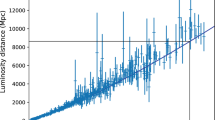Summary
The assumption that the Universe, just before the «big bang», consisted primarily of unitons (particles of mass\((\hbar c/4G)^{\tfrac{1}{2}} \)) leads to a simple picture of the big bang as the consequence of the gravitational collapse of triplets of unitons to form nucleons. If one assumes that the energy thus released caused the expansion of the Universe from some initial radiusR 0 to its present size, one obtaines simple equations forR 0 and the total numberN of nucleons in the Universe in terms of the basic constantsℏ,c andG. Using the known numerical values of these constants, one obtainsN=81/2·1079 andR 0=5.7·1012 cm. This model of the big bang also accounts for the large excess of photons over nucleons as a consequence of the creation of particle-antiparticle showers very shortly after the big bang. Stray unitons that never coalesced to form nucleons can explain many of the puzzling features of the Universe.
Riassunto
La considerazione che l’Universo, appena prima del «big bang», consistesse principalmente di unitoni (particelle di massa\((\hbar c/4G)^{\tfrac{1}{2}} \) porta ad un semplice quadro del big bang come conseguenza del collasso gravitazionale di tripletti di unitoni per formare nucleoni. Se si considera che l’energia così liberata abbia causato l’espansione dell’Universo da un certo raggio inizialeR 0 alla sua grandezza attuale, si ottengono semplici equazioni perR 0 ed il numero totaleN di nucleoni nell’Universo, in termini delle costanti fondamentaliℏ,c e,G. Usando i valori numerici conosciuti di queste costanti, si ottieneN=81/2·1079 eR 0=5.7·1012 cm. Questo modello di big bang tiene anche conto della grande sovrabbondanza di fotoni rispetto ai nucleoni in conseguenza della creazione di sciami particella-antiparticella poco dopo il big bang. Unitoni devianti che non si sono mai aggregati a formare nucleoni possono spiegare molti dei comportamenti misteriosi dell’Universo.
Резюме
Предположение, что Вселенная перед «большим взрывом» первоначально состояла из унитонов (частиц с массой ℏ приводит к простой картине большого взрыва, в результате гравитационного коллапса триплетов унитонов с образованием нуклонов. Если предположить, что освободившаяся энергия привеля к расширению Вселенной от начального радиусаR 0 до современных размеров, то получаются простые уравнения дляR 0 и полного числа нуклоновN во Вселенной в терминах основных постоянных ħ,c иG. Используя известные численные значения этих постоянных, можно получитьN=81/2·1079 иR 0=5.7·1012 см. Эта модель большого взрыва также учитывает большой избыток фотоноб над нуклонами, вследствие образования ливнеь частица-античастица очень вскоре после большого взрыва. Ълуждающие унитоны, которые не смогли коалесцировать в нуклоны, позволяют обьяснить многие загадочные особенности Вселенной.
Similar content being viewed by others
References
M. J. Rees:Q. J. R. Astron. Soc.,22, 109 (1981).
W. Heitler:Quantum Theory of Radiation, 2nd edition (Oxford, 1954), p. 281.
L. Motz:First Prize Essay, Gravity Research Foundation (1960); Nuovo Cimento,26, 1 (1962);Adv. Astronaut. Sci.,8, 476 (1962);Nature (London),189, 994 (1961);Nuovo Cimento A,65 326 (1970);Nuovo Cimento B,69, 95 (1970);12, 239 (1972);J. Epstein andL. Motz:Nuovo Cimento A,38, 345 (1977);L. Motz andJ. Epstein:Nuovo Cimento A,51 88 (1979); Columbia University Reprints CU-TP-5575 (1979), CU-TP 9776 (1980).
J. Oort:Science,170, 1363 (1970).
C. Møller:The Theory of Relativity, 1st edition (London 1952), p. 173.
W. Pauli:Wellenmechanik, edited byJ. W. Edwards (1946), p. 91.
A. Salam andJ. Strathdee:Phys. Rev. D,18, 4596 (1978).
V. M. Canuto:Riv Nuovo Cimento,1, No. 1 (1978).
Author information
Authors and Affiliations
Additional information
Traduzione a cura della Redazione
Переведено редакцией.
Rights and permissions
About this article
Cite this article
Motz, L. Cosmological consequences of the existence of the unit gravitational charge\((\hbar c/4G)^{\tfrac{1}{2}} \) . Nuov Cim B 73, 205–212 (1983). https://doi.org/10.1007/BF02721789
Received:
Published:
Issue Date:
DOI: https://doi.org/10.1007/BF02721789



